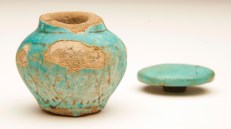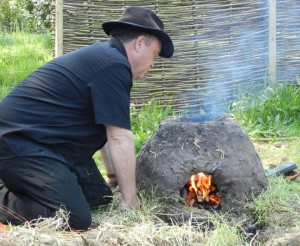Yesterday, I joined a team from the Caer Alyn Archaeological Heritage Project (CAAHP) as they attempted to recreate the ancient Egyptian art of faience production. Faience is a glazed non-clay ceramic material, composed mainly of crushed quartz or sand, with small amounts of lime and either natron or plant ash. The characteristic blue colour of Egyptian faience comes from a copper compound added to this mixture. Once fired, a thick glaze forms on the surface.
At the Manchester Museum we have around 2500 objects made of Egyptian faience, including one of my favourites – a bright blue libation cup of Nesi-khonsu, from the Deir el-Bahri royal cache. The material was widely used for vessels, shabtis, jewellery and amulets throughout the pharaonic period. In creating our new Ancient Worlds galleries we want to explain how this very attractive material – called tjehenet or ‘dazzling’ by the ancient Egyptians – was made.
In January I met Alan Brown of Daresbury Laboratory, who told me about his work recreating ancient kilns and his interest in ancient Egypt. He planned to build a clay kiln in an attempt to replicate the firing conditions that produced faience in ancient Egypt. Alan kindly agreed to talk about his experiments on film, to appear in the ‘exploring objects’ space of the new galleries. All the proceedings were filmed by the Museum’s media technician Luke Lovelock, and clips of the experiment will appear in the new galleries, with longer videos online.
This exciting case of experimental archaeology took place in a field just outside Wrexham in North Wales. It was perhaps the best day of the year to undertake such work – beautiful weather, and sunshine that seemed almost Egyptian! We were very lucky to have the services of a skilled set of volunteers from the CAAHP who have worked with Alan on a number of recreations before – not least the impressive roundhouse, next to where we were filming.
Alan’s team had built a small clay kiln in the weeks leading up to the experiment. They began by fuelling the kiln with wood and straw – as, presumably, would have been done in ancient Egypt. Alan had promised that dried cow pats would also be used as fuel, but – fortunately, I thought – this touch, however authentic, wasn’t available. Alan had prepared a number of small faience samples, made with different mixtures, including clay, gum arabic, and natron – a compound commonly used in mummification and simulated with table salt and bicarbonate of soda.
Each of the samples were placed on top of pebbles inside a lidded, fired clay container – or saggar – to sit at the centre of the kiln. An electronic probe was placed beneath the saggar to measure what temperature was reached in this hottest part of the kiln. Once the fuel began burning, and with careful stoking and sustained bellowing of air inside, a temperature of around 900 degrees Celsius was reached remarkably quickly. Although this core temperate fluctuated, it remained at between 800 and 900 degrees for about one and a half hours – providing the conditions thought ideal for the compounds in the faience to produce a glaze.
Once the kiln had been allowed to cool off somewhat, around three hours after the firing process had begun, we gathered round for the lid of the saggar to be removed. There was a real sense of expectation to see if the experiment had been a success – had the faience mixture been dry enough? Had the temperature been right? Was there enough bellowing? The results were astonishing: most of Alan’s greyish samples had turned bright Egyptian blue. Although the material remained rather porous, and did not show the shiney glaze typical of pharaonic examples, the experiment was declared a success. Conditions not dissimilar to those used in ancient Egypt had produced a passable imitation of this popular material.
Alan and his colleagues hope to make the results of their experiments more widely available soon. You can find out more on their other projects here. Footage from the kiln can be seen when the new galleries open at the end of October.






Hi there!
I was wondering if it would be possible to get more details about how the kiln to attempt to mimic the conditions that Egyptian faience was fired under was constructed? I am a student from the USA, on the East Coast, attempting to research and construct a kiln an Ancient Egyptian kiln of my own to try and conduct an experiment similar to the one that it looks like you all attempted here! Any information would be really helpful, if you could share it with me. I understand if that isn’t possible.
Thank you so much.
Sounds interesting – I’ll email you!
Pingback: Living in nature at Amarna « Egypt at the Manchester Museum